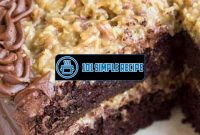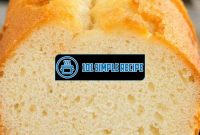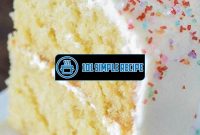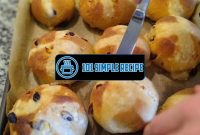If you’re craving a slice of heaven in the form of a moist and fluffy vanilla cake, then look no further! We have gathered a collection of delicious homemade vanilla cake recipes from scratch that will satisfy even the most discerning sweet tooth. These recipes are designed to bring out the rich and aromatic flavors of vanilla, creating a dessert that is both comforting and indulgent. Whether you’re a beginner baker or a seasoned pro, these recipes are sure to impress your friends and family with their delectable taste. So, tie up your apron strings and get ready to embark on a baking adventure that will leave you with a delectable treat fit for any occasion.
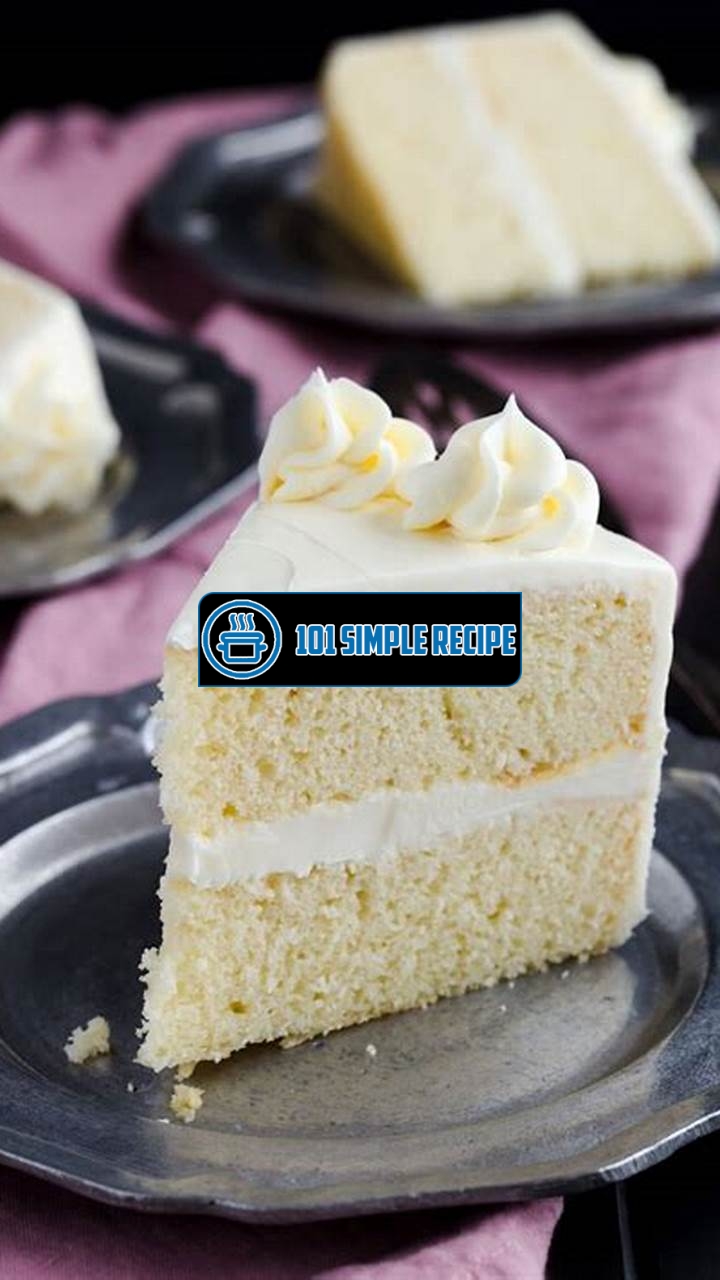
Understanding Homemade Vanilla Cake Recipes
When it comes to baking, there is something truly special about creating delicious homemade vanilla cake recipes from scratch. Whether you are an experienced baker or just starting out, understanding the basics and intricacies of making a homemade vanilla cake is vital. In this article, we will delve into the significance of homemade baking, explore the magic of vanilla, and take a glimpse into the ancient origins of cake.
The Significance of Homemade
Homemade baking holds a special place in many people’s hearts. The act of creating something from scratch in your own kitchen brings a sense of comfort and nostalgia. It allows you to control the quality of ingredients, customize the flavors, and experiment with various techniques. Homemade vanilla cake recipes offer a personal touch that store-bought cakes simply cannot replicate.
In addition to the sentimental value, homemade cakes also bring people together. Baking a vanilla cake from scratch can be a fun activity to do with your loved ones, creating lasting memories and bonding over the process. From measuring and mixing to licking the batter off the spoon, it’s a joyful experience that can be shared with family and friends.
The Magic of Vanilla
The star ingredient of any vanilla cake is, of course, vanilla. Vanilla extract adds a rich and delightful flavor to the cake, enhancing its sweetness and aroma. But did you know that vanilla comes from the pods of orchid plants? This natural ingredient has a fascinating story that dates back centuries.
The origins of vanilla can be traced back to ancient civilizations in Mesoamerica. The Aztecs and Mayans cultivated vanilla orchids and used the beans for various purposes, including flavoring drinks and as a form of currency. When Spanish conquistadors discovered vanilla, they brought it back to Europe, where its popularity quickly spread.
Ancient Origins of Cake
Cakes have been enjoyed by civilizations throughout history. Ancient Egyptians, Greeks, and Romans all had their own versions of cakes, often made with ingredients such as honey, wheat flour, and olive oil. The concept of cake as a sweet treat has stood the test of time and has evolved into the beloved dessert we know today.
In medieval Europe, cakes became more extravagant and were often served at special occasions like weddings and religious celebrations. The tradition of tiered cakes, adorned with intricate designs and decorations, began to take shape. Over the centuries, different regions and cultures have put their own spin on cakes, resulting in a wide variety of flavors, shapes, and styles.
So, the next time you embark on creating your own homemade vanilla cake from scratch, remember the history and significance behind it. Embrace the joy of homemade baking, savor the magic of vanilla, and appreciate the ancient origins of this beloved dessert. Happy baking!
Gathering Essential Ingredients
When it comes to making a delectable homemade vanilla cake from scratch, it all starts with gathering the key ingredients. These essential components will ensure that your cake turns out moist, flavorful, and absolutely delicious. So, let’s dive in and explore what you’ll need to create this delectable treat.
The Importance of High-Quality Ingredients
Using high-quality ingredients is crucial when it comes to baking a homemade vanilla cake that truly stands out. Not only do top-notch ingredients enhance the flavor, but they also contribute to the overall texture and richness of the cake. When shopping for ingredients, opt for organic and fresh products whenever possible.
Note: High-quality ingredients will greatly elevate the taste and quality of your homemade vanilla cake. Don’t skimp on quality!
The key ingredients for a homemade vanilla cake include:
- All-Purpose Flour: This acts as the base for the cake and provides structure.
- Granulated Sugar: Adds sweetness and aids in the cake’s tender crumb.
- Butter: Use unsalted butter to have better control over the salt content in the cake.
- Eggs: Provide moisture, structure, and help with leavening.
- Milk: Adds moisture and richness to the cake batter.
- Baking Powder: Helps the cake rise and gives it a light and fluffy texture.
- Salt: Balances the sweetness of the cake and enhances the overall flavor.
- Pure Vanilla Extract: Gives the cake its distinct vanilla flavor.
Additionally, you may want to consider adding a pinch of salt, which helps to enhance the flavors in your cake and balance out the sweetness.
Proper Measurements for Success
Accurate measurements are crucial when it comes to baking a homemade vanilla cake. Too much or too little of any ingredient can significantly impact the final result. To ensure your cake turns out perfectly, use standard measuring cups and spoons and level off the ingredients to ensure accuracy.
When measuring flour, avoid scooping it directly from the bag, as this can result in a packed cup and lead to a dense cake. Instead, spoon the flour into the measuring cup and level it off with a straight edge for precise measurements.
Note: Proper measurements are vital for achieving a light, fluffy, and moist homemade vanilla cake.
Exploring Vanilla Varieties
While traditional vanilla extract is the most commonly used form of vanilla for homemade cakes, there are other varieties worth exploring. These include:
- Vanilla Bean Paste: Made from vanilla beans and adds tiny vanilla seeds to your cake batter, providing a unique visual appeal.
- Vanilla Powder: Offers a convenient and concentrated form of vanilla flavor. It can be easily mixed into the dry ingredients.
- Homemade Vanilla Extract: You can even create your own vanilla extract by infusing vanilla beans in alcohol. This adds a personal touch to your homemade vanilla cake.
Note: Experimenting with different forms of vanilla can add an extra layer of flavor and uniqueness to your homemade vanilla cake. Enjoy exploring!
Now armed with the knowledge of gathering essential ingredients for your homemade vanilla cake, you’re ready to embark on a delicious baking adventure. So, roll up your sleeves, preheat the oven, and get ready to enjoy the aroma and taste of a scrumptious homemade vanilla cake!
Mastering the Art of Mixing
When it comes to baking a delicious homemade vanilla cake from scratch, mastering the art of mixing is key. The techniques you use to combine your ingredients can greatly impact the texture and consistency of your cake batter, ultimately determining the success of your final result. So, let’s dive deeper into the science of mixing and explore some tips to achieve the ideal batter for your vanilla cake.
The Science Behind Mixing
Understanding the science behind mixing will help you become a better baker. When you mix the ingredients for your homemade vanilla cake, certain reactions occur that contribute to the chemistry of baking. One important reaction is the formation of gluten. When you mix the wet ingredients into the dry ones, the proteins in the flour combine with liquids to form gluten. Gluten gives structure to your cake and helps it rise.
✨ Tip: Use cake flour instead of all-purpose flour to achieve a softer and more tender texture in your vanilla cake.
Incorporating Dry and Wet Ingredients
Properly incorporating the dry and wet ingredients is crucial for achieving a well-mixed batter. Start by sifting your dry ingredients together, such as flour, baking powder, and salt, to ensure they are evenly distributed. In a separate bowl, mix together your wet ingredients, including eggs, milk, vanilla extract, and melted butter.
Next, gradually add the wet mixture to the dry ingredients. It’s important to mix gently and avoid over-mixing, as this can lead to a dense and tough cake. A few lumps in the batter are okay – they will dissolve during baking.
✨ Tip: To add a burst of flavor to your homemade vanilla cake, try substituting some of the milk with buttermilk or adding a tablespoon of sour cream to the batter.
Tips for Achieving the Ideal Batter
Now, let’s dive into some additional tips to help you achieve the ideal batter consistency for your homemade vanilla cake.
- 1. Room temperature ingredients: Ensure that your eggs, milk, and butter are at room temperature before incorporating them into the batter. This will promote better mixing and result in a smoother batter.
- 2. Measure accurately: Use measuring cups and spoons to accurately measure your ingredients. In baking, precision matters, and small deviations can affect the final outcome of your cake.
- 3. Avoid over-mixing: Over-mixing the batter can lead to a dense and dry cake. Mix until the ingredients are just combined, and then stop. This will help maintain a tender and light texture.
- 4. Use the right mixing speed: Depending on your recipe, follow the recommended mixing speed. Most cake batters require low to medium speed to prevent excess air from being incorporated into the batter.
✨ Tip: For an extra moist and flavorful homemade vanilla cake, brush a simple syrup made from equal parts sugar and water over the baked cake layers before frosting.
With these techniques and tips in your baking arsenal, you can confidently create a delicious homemade vanilla cake from scratch. Remember to experiment and have fun with different variations to suit your preferences. Happy baking!
Baking the Perfect Homemade Vanilla Cake
Discover the secrets to baking a moist and flavorful homemade vanilla cake every time.
The Right Temperature and Timing
When it comes to baking a delicious homemade vanilla cake, getting the temperature and timing just right is crucial. Preheat your oven to 350°F (175°C) for the perfect balance of heat without drying out the cake. This temperature ensures even cooking and a moist texture.
Timing is equally important. It’s essential to follow the recipe instructions and set a timer to avoid overbaking or underbaking the cake. Overbaking can result in a dry and crumbly texture, while underbaking can lead to a gooey and undercooked center.
Remember to test the cake’s doneness by inserting a toothpick into the center. If it comes out clean or with a few crumbs attached, the cake is ready to be taken out of the oven. Allow the cake to cool completely before frosting or decorating to ensure the best results.
Choosing the Ideal Bakeware
The type of bakeware you use can greatly affect the outcome of your homemade vanilla cake. Opt for light-colored aluminum or stainless steel cake pans. These materials promote even heat distribution and result in a well-baked cake.
Avoid using dark-colored or non-stick pans as they tend to absorb more heat and can cause the edges of the cake to overcook or burn. Additionally, non-stick pans can lead to a lack of browning, resulting in a pale and unappetizing appearance.
Another essential factor in choosing the ideal bakeware is the size of the cake pan. Depending on the recipe, you may need to use different sized pans. Be sure to follow the recipe’s instructions regarding pan size for optimal baking results.
Troubleshooting Common Baking Issues
Baking a homemade vanilla cake can sometimes come with a few challenges. Here are some common issues that may arise and how to troubleshoot them:
- Dry or Dense Cake: If your cake turns out dry or dense, it may be due to overmixing the batter. Overmixing can cause too much gluten development, resulting in a tough texture. Mix the batter just until the ingredients are combined to avoid this issue.
- Sunken Center: A sunken center is usually a sign of underbaking. Ensure that you bake the cake for the recommended time and thoroughly test for doneness before removing it from the oven.
- Burned Edges: Burned edges can occur if the oven temperature is too high or if the cake pans are dark-colored. Reduce the oven temperature slightly and consider switching to light-colored pans for your next bake.
- Unevenly Baked Cake: Uneven baking can be caused by an uneven oven temperature or using pans of different sizes. Make sure your oven is calibrated correctly and use the recommended pan size for the recipe.
- Cake Sticking to the Pan: To prevent your cake from sticking to the pan, ensure that it is properly greased and floured before pouring in the batter. You can also line the bottom of the pan with parchment paper for extra insurance.
Note: It’s important to remember that baking can sometimes be a trial-and-error process. Don’t be discouraged if your first attempt doesn’t turn out exactly as planned. Use these troubleshooting tips and keep practicing to master the art of baking the perfect homemade vanilla cake.
By following these tips for temperature and timing, choosing the ideal bakeware, and troubleshooting common baking issues, you’ll be well on your way to creating delicious homemade vanilla cakes from scratch. Experiment with flavors and decorations to make each cake your own masterpiece. Happy baking!
Delectable Frosting and Decorations
Dive into the world of frosting options and creative cake decorations that will elevate your homemade vanilla cake. From luscious creams to intricate designs, there are countless ways to make your cake truly special.
Exploring Frosting Techniques
When it comes to frosting your homemade vanilla cake, the options are endless. One popular choice is buttercream frosting, which is rich and creamy, adding a flavorful touch to your cake. Another option is cream cheese frosting, which has a tangy and slightly sweet taste that pairs perfectly with the vanilla cake.
Pro Tip: For an extra twist of flavor, try adding a hint of lemon zest or a dash of cocoa powder to your frosting. This will give your cake an added depth and complexity that will impress your guests.
If you’re feeling adventurous, you can also experiment with whipped cream frosting. Light and airy, this frosting is perfect for those who prefer a less sweet option. It complements the vanilla cake beautifully and adds a refreshing element to each bite.
No matter what frosting technique you choose, make sure to spread it evenly on your cake for a smooth and professional look. Use an offset spatula or a butter knife to achieve the desired effect.
Unique Decoration Ideas
Take your homemade vanilla cake to the next level with unique and eye-catching decorations. One option is to create a stunning ombre effect by using different shades of frosting. Start with a light shade and gradually add more food coloring to achieve a darker shade as you work your way up the cake.
Pro Tip: Use a piping bag and a star-shaped nozzle to create beautiful rosettes or other intricate designs on your cake. This adds a touch of elegance and sophistication to your dessert.
If you’re looking for a fun and playful decoration idea, consider making edible flowers out of fondant or candy melts. These delicate and colorful blooms will make your homemade vanilla cake look like a work of art.
Another creative option is to incorporate different textures into your cake. For example, you can add a crunchy element by sprinkling chopped nuts or crumbled cookies on top of the frosting. This not only adds visual interest but also enhances the overall taste and mouthfeel of your cake.
Adding a Personal Touch to Your Cake
Make your homemade vanilla cake truly special by adding a personal touch. One idea is to incorporate a theme into your cake design. Whether it’s a favorite movie, a beloved hobby, or a special event, let your creativity run wild and design a cake that reflects your personality or the occasion.
Pro Tip: Customize your cake by adding a personalized message or a name using edible lettering. You can use piped frosting, fondant cut-outs, or even edible markers to create a heartfelt message or a celebratory greeting.
Additionally, consider incorporating unique flavors or fillings between your cake layers. Try adding a layer of fresh berries, a drizzle of caramel sauce, or a spread of your favorite jam. This unexpected twist will surprise and delight your guests.
Finally, don’t forget to top off your cake with a captivating cake topper. Whether it’s a simple monogram, a whimsical figurine, or a handmade sugar sculpture, the right topper can instantly elevate the look of your homemade vanilla cake and make it a centerpiece at any celebration.
With these delectable frosting techniques, unique decoration ideas, and personal touches, your homemade vanilla cake will be a delightful treat that everyone will love. So go ahead and let your creativity shine as you create a cake that not only tastes amazing but also looks like a masterpiece.
Frequently Asked Questions
Here are a few frequently asked questions about homemade vanilla cake recipes from scratch:
| No. | Questions | Answers |
|---|---|---|
| 1. | What are the key ingredients for a homemade vanilla cake? | The key ingredients for a homemade vanilla cake include all-purpose flour, sugar, eggs, butter, milk, vanilla extract, and baking powder. These ingredients come together to create a deliciously moist and flavorful cake. |
| 2. | Can I substitute butter with oil in a vanilla cake recipe? | Yes, you can substitute butter with oil in a vanilla cake recipe. However, keep in mind that butter adds a rich flavor to the cake, so the taste may slightly differ. If you prefer a lighter texture, using oil can be a good option. |
| 3. | How can I make my homemade vanilla cake more moist? | To make your homemade vanilla cake more moist, you can add ingredients like sour cream or buttermilk to the batter. These ingredients help retain moisture and create a tender texture in the cake. |
| 4. | Can I freeze a homemade vanilla cake? | Yes, you can freeze a homemade vanilla cake. Make sure to wrap it tightly in plastic wrap or aluminum foil before placing it in the freezer. When you’re ready to enjoy it, let it thaw at room temperature for a few hours. |
| 5. | How long does a homemade vanilla cake stay fresh? | A homemade vanilla cake can stay fresh for up to 4-5 days when stored properly in an airtight container at room temperature. After that, it may start to dry out, so it’s best to enjoy it within the first few days. |
| 6. | Can I add other flavors to a homemade vanilla cake? | Absolutely! You can experiment with different flavors by adding ingredients like chocolate chips, fruit extracts, or even spices like cinnamon or nutmeg. Get creative and make your vanilla cake uniquely delicious. |
Closing Thoughts
Thank you for taking the time to read about these delectable homemade vanilla cake recipes from scratch! We hope this article has inspired you to try your hand at baking these mouthwatering treats. Remember, the joy of baking lies in the process as well as the end result, so enjoy every step and savor the delightful aroma that fills your kitchen. Don’t forget to visit us again for more tempting recipes and culinary inspiration. Happy baking!
Jump to Recipe
Homemade Vanilla Cake Recipes from Scratch

Learn how to make delicious homemade vanilla cakes from scratch with these easy-to-follow recipes. Moist, fluffy, and bursting with vanilla flavor, these cakes are perfect for any occasion.
- 2 and 1/2 cups all-purpose flour
- 1 and 3/4 cups granulated sugar
- 1 cup unsalted butter (softened)
- 4 large eggs
- 1 cup milk
- 1 tablespoon vanilla extract
- 2 and 1/4 teaspoons baking powder
- 1/2 teaspoon salt
- Preheat the oven to 350°F (180°C). Grease and flour two 9-inch (23cm) round cake pans.
- In a large mixing bowl, whisk together the flour, sugar, baking powder, and salt.
- Add the softened butter, eggs, milk, and vanilla extract to the dry ingredients. Beat on medium speed for 2 minutes until the batter is smooth and well combined.
- Divide the batter equally between the prepared cake pans. Bake for 25-30 minutes or until a toothpick inserted into the center comes out clean. Remove the cakes from the oven and let them cool in the pans for 10 minutes. Transfer the cakes to a wire rack to cool completely.
- Once the cakes have cooled, frost them with your favorite frosting and decorate as desired. Enjoy!

